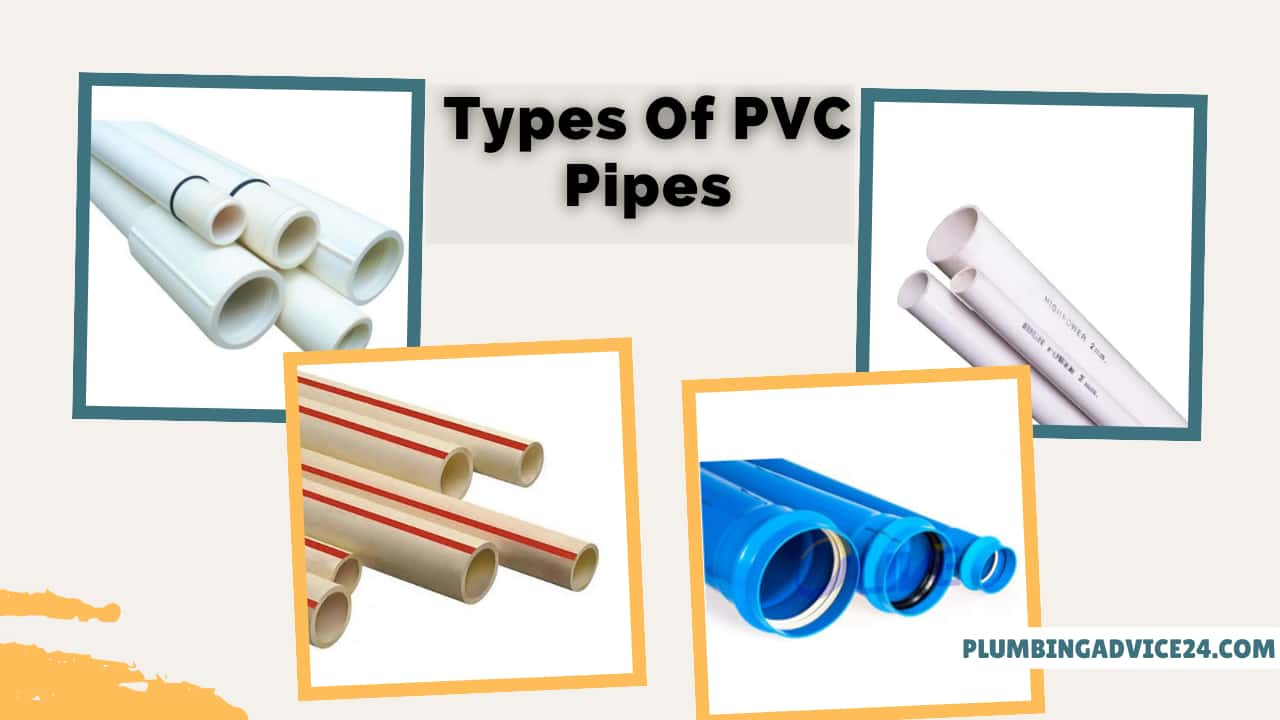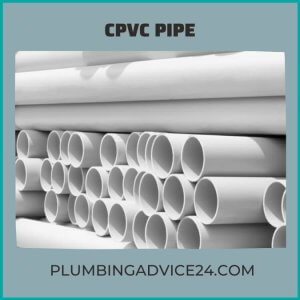Types of PVC Pipes | Schedule 40 Vs Schedule 80
PVC pipes have been widely used since the early 20th century. The first PVC water pipes were made in Germany. A few years later, these pipes took the place of drinking water pipes and waste drainage in every home there. At that time, the common types of PVC pipes were the same. But now, PVC pipes are designed in many types to meet the demand of different applications.
If you go to the nearest store to buy PVC pipe, you may be confused by its different types and sizes. But if you need to install PVC pipes, you don’t have to worry, as we will give you all the information you need. You should read the following article to understand the types of PVC pipes.
How Many Types of PVC Pipe?
Currently, PVC pipe is the most widely used for plumbing in general. These pipes can withstand water pressure without tearing or breaking and are also durable. Fixing a PVC leak is easier than fixing a copper or other sewer pipe, which is why plumbers prefer it.
They are durable and recyclable, which makes them more earth-friendly than pipes made from other materials. As the plumber calls it all ‘plastic pipes,’ but people don’t know that different types of PVC pipes exist.
There are four types of PVC pipe, which are as follows:
- Unplasticized PVC (U-PVC)
- Chlorinated PVC (C-PVC)
- Molecularly Oriented PVC (PVC-O)
- High Impact PVC (PVC-Hi)
All types differ in many ways in terms of durability, safety, and reusability. Each is good for the use of its specific application, and each has its own advantages.
1. Unplasticized PVC (uPVC)
“u” in uPVC means “unplasticized”, uPVC is a pipe made without a plasticizer. These are not extra materials; the plasticizer increases the plasticity and reduces the viscosity, which makes the material gentle and flexible. These types of PVC pipes are often called hard plastic.
A uPVC pipe is lightweight, inexpensive, easy to handle, non-toxic, and chemical-free, making UPVC pipes the perfect choice for transporting drinking water. It is capable of withstanding high chemical resistance, mechanical performance, and UV exposure.
Also, since unplasticized PVC can be completely recycled, it is considered to be an environmentally friendly pipe.
Unplasticized PVC pipe is commonly used for:
- Pipes and fittings.
- Transport of drinking water, waste, and soil.
- Sewer.
- Industrial drainage.
- Industrial applications.
2. Chlorinated PVC (CPVC)
“CPVC” means chlorinated polyvinyl chloride. They are made by the chlorination of PVC resins, which effectively increases the content of chlorine in the material. It is a thermoplastic molded into products similar to PVC.
Manufacturers introduced them for potable plumbing in 1959, but their manufacturing process changed slightly.
Chlorinated PVC pipes are safe to use for drinking water and are also extremely resistant to corrosion. In addition, because they are high-temperature resistant, they make an ideal alternative to sewer systems used in both residential areas and commercial construction.
They are even more flexible than uPVC as they contain plasticizers. It is appreciated by environmentalists all over the world as it can be completely recycled.
CPVC pipes have many advantages over unplasticized PVC pipes. Because of this, they are a popular choice for:
- Pipes and fittings
- Transport of drinking water
- Carrying water with a wide range of temperatures
- Management of industrial fluids
3. Molecularly Oriented PVC (PVC-O)
PVC-O or Molecularly Oriented PVC is one of the different types of PVC pipe which converts the amorphous structure of unplasticized PVC (PVC-U) into a layered structure.
PVC-O enhances many advantages of uPVC, such as high resistance to corrosion, reusability, water quality maintenance, and cost-efficiency. These types of PVC pipes are widely used as pressure pipes for drinking water. If you live in an area where pipes are normally exposed to pressure, you may want to consider using these pipes.
They provide a unique balance between inertia, flexibility, and elasticity. Molecularly Oriented PVC pipes have properties such as large hydraulic capacity, resistance to cracks, and gentleness so that they can last longer and resist fatigue and impact.
This is very important for many homeowners and professionals as they can be 100% recycled.
The use of molecularly oriented PVC pipes is as follows.:
- Pipes and fittings where strong pressure is expected
- A sewer system is unstable on plains
- Irrigation pipes
- Sewer pumping mains
4. High Impact PVC (PVC-Hi)
PVC-Hi or High Impact PVC is the newest type of PVC pipe. Manufacturers introduce various chemicals into PVC-U to increase the resistance to external blows of pipes.
While standard PVC had many advantages, its use was limited because it was unstable. To overcome this problem, professionals created a PVC alloy, which was a mixture of polycarbonate. So that alloys with high dimensional stability are formed, which can be particularly resistant to heat or pressure.
These alloys are usually made of polycarbonate and vinyl chloride resins. Other ingredients include butadiene-modified and acrylic ethylene-vinyl acetate, both of which make the variation material very rigid.
PVC-Hi is used in cases where standard PVC is unable to control pressure or excessive temperature.
Because of this, it is commonly used in industrial liquid or commercial sewer systems. This pipe is the best choice if you are planning to connect 2 pipes, as it is not damaged while cutting.
Must Read : What Is Plumbing Pipe | 22 Different Types of Plumbing pipes And Their Uses
What are Schedule 40 and Schedule 80 PVC Pipes?
If you are buying PVC pipe, you may have heard the word “schedule.” Different from the above types, these can only be distinguished by looking at the two.
Schedule 40 PVC pipes are usually white, while Schedule 80 PVC pipes are dark gray. The schedule of PVC pipe is related to the thickness of its walls. We will explain below.
The main differences between Schedule 40 and 80 are as follows, which distinguish them from each other.
- Water pressure rating
- Inner diameter
- Weight
- Cost
Let’s see more about this difference,
1. Water Pressure Rating
Schedule 40 and 80 PVC are both similar, but the main difference between the two is their thickness. However, both have different advantages for different applications. Schedule 40 pipes have thin walls, so they are best for relatively low water-pressure applications.
Schedule 80 is able to withstand the high pressure of water, as these pipes have thick walls. These pipes are considered ideal for industrial and chemical applications. It is used to transport water under high pressure. It is used in situations where people expect a lot of external pressure.
Despite this, the Schedule 40 PVC pipes are what you typically see in your homes or commercial spaces. The buildings in which the white pipeline provides drainage are Schedule 40 PVC pipes. You can easily find it at your nearest hardware store.
However, if you need a higher pressure level, you should use Schedule 80 instead.
2. Inner Diameter
The outer diameters of both Schedule 80 and Schedule 40 PVC pipes are exactly the same. Imagine that if both types of PVC pipes were of the same color, it would be impossible to identify them by looking at them.
But, if you are cutting PVC pipe, you will see another difference in it, which is the inside diameter of the pipe.
When they seem equally thick, the inside diameter of Schedule 80 pipes is significantly smaller than Schedule 40. This is because the extra thickness of the wall in Schedule 80 pipes is inside the pipe.
Thicker walls make them stronger and more rigid compared to Schedule 40. This is a disadvantage. The Schedule 80 pipe will have slightly more restricted flow than the Schedule 40.
3. Weight
As we saw further, the Schedule 80 pipes are thicker than the Schedule 40 pipes, which means that the Schedule 80 pipes are heavier than the Schedule 40 pipes.
Their use depends on your need. The purpose for which you want to install it may limit your options. When buying PVC pipes, you need to keep in mind that installing Schedule 80 pipes can be more expensive.
4. Cost
The cost of a Schedule 80 is always more expensive than a Schedule 40 pipe of the same outer diameter. The increased cost of Schedule 80 PVC pipes can be attributed to their thicker wall construction, which requires more material and manufacturing processes. Additionally, Schedule 80 pipes are designed to withstand higher pressures, which may involve additional quality control measures during production.
It’s worth noting that the price difference between Schedule 40 and Schedule 80 PVC pipes may not be significant for smaller-diameter pipes or shorter lengths. However, as the diameter and length increase, the cost disparity becomes more noticeable.
Must Read : What Is Pipe Fittings | 12 Types of Pipe Fittings Their Uses And Design
PVC Pipe Schedule 40 and Schedule 80 Size Chart
The main differences between schedule 40 vs 80 PVC pipes are wall thickness, inside diameter, and weight. Schedule 80 will have a greater wall thickness, smaller inside diameter, and weight more than Schedule 40 pipe at a given nominal pipe size.
Of course, all these numbers will vary depending on the nominal pipe size. The use of a pipe schedule table is important to ensure that the correct pipe size is selected. Here we have given the size chart of PVC Pipe Schedule 40 and Schedule 80.
PVC Pipe Schedule 40 Size Chart
Here, the table is the schedule 40 PVC pipe dimensions chart.
| Schedule 40 PVC Pipe Dimensions | |||||
| Nom. Pipe Size (in) | O.D. | Average I.D. | Minimum Wall | Nominal Wt./Ft. | Maximum W.P. PSI* |
| 1/8 | 0.405 | 0.249 | 0.068 | 0.051 | 810 |
| 1/4 | 0.540 | 0.344 | 0.088 | 0.086 | 780 |
| 3/8 | 0.675 | 0.473 | 0.091 | 0.115 | 620 |
| 1/2 | 0.840 | 0.602 | 0.109 | 0.170 | 600 |
| 3/4 | 1.050 | 0.804 | 0.113 | 0.226 | 480 |
| 1 | 1.315 | 1.029 | 0.133 | 0.333 | 450 |
| 1-1/4 | 1.660 | 1.360 | 0.140 | 0.450 | 370 |
| 1-1/2 | 1.900 | 1.590 | 0.145 | 0.537 | 330 |
| 2 | 2.375 | 2.047 | 0.154 | 0.720 | 280 |
| 2-1/2 | 2.875 | 2.445 | 0.203 | 1.136 | 300 |
| 3 | 3.500 | 3.042 | 0.216 | 1.488 | 260 |
| 3-1/2 | 4.000 | 3.521 | 0.226 | 1.789 | 240 |
| 4 | 4.500 | 3.998 | 0.237 | 2.118 | 220 |
| 5 | 5.563 | 5.016 | 0.258 | 2.874 | 190 |
| 6 | 6.625 | 6.031 | 0.280 | 3.733 | 180 |
| 8 | 8.625 | 7.942 | 0.322 | 5.619 | 160 |
| 10 | 10.750 | 9.976 | 0.365 | 7.966 | 140 |
| 12 | 12.750 | 11.889 | 0.406 | 10.534 | 130 |
| 14 | 14.000 | 13.073 | 0.437 | 12.462 | 130 |
| 16 | 16.000 | 14.940 | 0.500 | 16.286 | 130 |
| 18 | 18.000 | 16.809 | 0.562 | 20.587 | 130 |
| 20 | 20.000 | 18.743 | 0.593 | 24.183 | 120 |
| 24 | 24.000 | 22.544 | 0.687 | 33.652 | 120 |
PVC Pipe Schedule 80 Size Chart
Here, the table is the schedule 80 PVC pipe dimensions chart.
| Schedule 80 PVC Pipe Dimensions | |||||
| Nominal Pipe Size (in) | O.D. | Average l.D. | Minimum Wall | Nominal Wt./ft. | Maximum W.P. PSI* |
| 1/8 | 0.405 | 0.195 | 0.095 | 0.068 | 1230 |
| 1/4 | 0.540 | 0.282 | 0.119 | 0.115 | 1130 |
| 3/8 | 0.675 | 0.403 | 0.126 | 0. 158 | 920 |
| 1/2 | 0.840 | 0.526 | 0.147 | 0.232 | 850 |
| 3/4 | 1.050 | 0.722 | 0.154 | 0.314 | 690 |
| 1 | 1.315 | 0.936 | 0.179 | 0.461 | 630 |
| 1-1/4 | 1.660 | 1.255 | 0.191 | 0.638 | 520 |
| 1-1/2 | 1.900 | 1.476 | 0.200 | 0.773 | 470 |
| 2 | 2.375 | 1.913 | 0.218 | 1.070 | 400 |
| 2-1/2 | 2.875 | 2.29 | 0.276 | 1.632 | 420 |
| 3 | 3.500 | 2.864 | 0.300 | 2.186 | 370 |
| 4 | 4.500 | 3.786 | 0.337 | 3.196 | 320 |
| 6 | 6.625 | 5.709 | 0.432 | 6.102 | 280 |
| 8 | 8.625 | 7.565 | 0.500 | 9.269 | 250 |
| 10 | 10.750 | 9.493 | 0.593 | 13.744 | 230 |
| 12 | 12.750 | 11.294 | 0.687 | 18.909 | 230 |
| 14 | 14.000 | 12.41 | 0.750 | 22.681 | 220 |
| 16 | 16.000 | 14.213 | 0.843 | 29.162 | 220 |
| 18 | 18.000 | 16.014 | 0.937 | 36.487 | 220 |
| 20 | 20.000 | 17.814 | 1.031 | 44.648 | 220 |
| 24 | 24.000 | 21.418 | 1.218 | 63.341 | 210 |
Must Read : What Is Plumbing Trap | 15 Different Types of Plumbing Traps And Their Uses And Design
What Are the Types of Plastic Pipes?
Plastic pipes are durable and recyclable, which makes them more earth-friendly than pipes made from other materials. As the plumber calls it all, ‘plastic pipes’, but people don’t know that different types of PVC plastic pipes exist.
There are four types of PVC pipe, which are as follows:
- Unplasticized PVC (U-PVC)
- Chlorinated PVC (C-PVC)
- Molecularly Oriented PVC (PVC-O)
- High Impact PVC (PVC-Hi)
What Is a uPVC Pipe?
“u” in uPVC means “unplasticized”, uPVC is a pipe made without a plasticizer. These are not extra materials; the plasticizer increases the plasticity and reduces the viscosity, which makes the material gentle and flexible. uPVC is often called hard plastic.
Also, since uPVC can be completely recycled, it is considered to be an environmentally friendly pipe.
uPVC pipe use for:
- Pipes and fittings.
- Transport of drinking water, waste, and soil.
- Sewer.
- Industrial drainage.
- Industrial applications.
Can Use CPVC Pipe for Hot Water?
CPVC is a strong and rigid thermoplastic material made by the chlorination of PVC resin. It effectively increases the content of chlorine in the material. Since it has high-temperature tolerance, CPVC for hot water is safe and is used for hot and cold drinking water in residential construction.
What Is the Difference Between PVC Schedule 40 Vs 80?
Schedule 40 PVC pipes are usually white, while Schedule 80 PVC pipes are dark gray. The schedule of PVC pipe is related to the thickness of its walls.
The main difference between schedules 40 and 80 PVC pipes are as follows, which distinguish them from each other.
- Water pressure rating
- Inner diameter
- Weight
- Cost
What Is Schedule 80 PVC Pipe Used For?
Schedule 80 PVC pipes are able to withstand the high pressure of water, as these pipes have thick walls. These pipes are considered ideal for industrial and chemical applications. It is used to transport water under high pressure. It is used in situations where people expect a lot of external pressure.
If You Liked This Post? So Share It with Your Friends
Suggested Articles:
- How to Repair PVC Pipe | How to Replace PVC Pipe | PVC Pipe Repair Without Cutting
- What Is ABS Pipe | Why Is ABS Pipe Prohibited | ABS Pipe lifespan | How to Measure ABS Pipe Size | Advantages and Disadvantages of ABS Pipe
- Different Types of PEX Pipe | How to Make PEX Connections
- What Is Copper Pipe | Types of Copper Pipes | Copper Pipe Cost | How to Measure Copper Pipe Size | Advantages and Disadvantages of Copper Pipe
- How Many Types of Metal Pipes | Different Metal Pipe Manufacturing Process | How to Choose Metal Pipes













